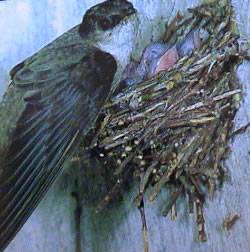I used to think birdwatching is boring. In the city where I lived, most common birds where sparrows, pigeons, seagulls, crows and ravens. They were all mostly black and gray and I found nothing interesting in watching them. Maybe because I so very much got used to them and, in a way, they were simply part of a well known landscape. Or maybe I because I was too busy. Or maybe both.
 |
| Baltic Sea seagulls |
In Texas, due to the climate difference, wildlife - fauna and flora - is obviously not exactly the same as in Poland. It is interesting to see birds, plants and animals new to me. I not only enjoy watching them but also learning something about these unknown (to me) species.
In our neighborhood there was an area with a very old wood, trees and bushes untouched by humans for ages. With a little stream, it was a habitat and home for various kinds of creatures including many birds. Their songs and chirps were heard from early morning till the night. I loved listening to their voices. Especially the cardinal's calls were quite distinguished. Since the wood was not far from our house, I could observe the birds sitting in the trees and flying around our yard.
Here are some of them which I really liked.
1. My favorite one -
Northern Cardinal. They sing so beautifully!
The males, so pretty in red, because of their color were easy to spot among the greenery of the woods. The females are pale grayish brown with some reddish pink bill, not that noticeable at all.
2.
Blue Jay - size: 10-11" (25.5/28cm)
They are also great vocalists and wonderful singers. Sometimes they even imitate hawk screams.
3.
Northern Mockingbird - size: 9-10" (23-25.5cm)
The mockingbird can not only imitate other birds but also incorporate many various sounds into their repertoire (eg. barking dogs). Both males and females are alike in appearance.
4.
House Sparrow - size: 51/2-6" (14/15cm)
 |
| Male House Sparrow |
My favorite city bird which cousins live in Poland also. The male has a gray crown and gray rump. The female is dingy gray. Size: 51/2-6" (14/15cm).
5.
Ruby-throated Hummingbird
These are very difficult to spot as they are so tiny (31/4 - 31/2"/ 8-9cm)! I have seen them twice maybe - thanks to my husband who noticed them and showed them to me.
It was so great having all the beautiful singers around! The area was also full of other musicians - katydids, crickets and similar instrumentalists which played their loud music days and nights.
/
One sad day the wood was cut down and destroyed, and so were the animals' lives. Only a few trees were left. It was so terrible, especially that the little woodland had also been a stop for flocks of migrating birds - since always I guess. When the season came, once we heard lots of birds' cries, we looked out and saw plenty of yellowish birds, sitting on the three trees - the remains of the wild land. Many were flying around as if they had not known where to sit. They looked disoriented and confused. - no high branches to rest, no water to drink (the stream had been covered with concrete), no bugs to eat. It was all so sad! Probably quite a lot of those birds did not survive that migrating season.
Great Crested Flycatcher - size: 8-83/4" (20.5/22cm)
It eats large birds and dwells in treetops. Migrates to Mexico and South America in April.
All in all, with no trees around, most of the birds were gone. So it was nothing to be sorry about leaving the place when our migrating time came.
Some other birds which are quite popular here and do not occur in Poland:
- Mourning Dove - they are quite lovely. A couple of them visits our patio quite often. I like them too! They migrate to South America in September. Size: 10-12" (25.5/30cm)
 |
| Mourning Doves are monogamous birds |
Interesting though maybe not that cute:
- Common Grackle - size: 10-12" (25.5/30.5 cm)
- Great-tailed grackle - size: 101/2-181/2" (26.5/47cm)
Quite noisy guys. Usually there are a lot of them around supermarkets, looking for something to eat. "In Mexico, where it is known as the
chanate or
zanate,
there is a legend that it has seven songs. 'In the creation, the Zanate
having no voice, stole its seven distinct songs from the wise and
knowing sea turtle. You can now hear the Zanate's vocals as the Seven
Passions (Love, Hate, Fear, Courage, Joy, Sadness, and Anger) of life.'" (citation from wikipedia)
Credits: pictures of American birds & birds' sounds source - wikipedia.org
Northern Cardinal: By Stephen Wolfe from Columbus,
OH, USA (Northern Cardinal I Uploaded by Snowmanradio) [CC BY 2.0
(http://creativecommons.org/licenses/by/2.0)], via Wikimedia Commons;
Blue
Jay: By Mdf (Own work) [GFDL (http://www.gnu.org/copyleft/fdl.html) or
CC-BY-SA-3.0 (http://creativecommons.org/licenses/by-sa/3.0/)], via
Wikimedia Commons;
Northern
Mockingbird: By Captain-tucker (Own work) [CC BY-SA 3.0
(http://creativecommons.org/licenses/by-sa/3.0)], via Wikimedia Commons;
House
Sparrow: By Passer_domesticus_on_rose.jpg: PewuCom derivative work:
Totodu74 (Passer_domesticus_on_rose.jpg) [CC BY 3.0
(http://creativecommons.org/licenses/by/3.0) or GFDL
(http://www.gnu.org/copyleft/fdl.html)], via Wikimedia Commons;
Ruby-throated hummingbird: public domain, U.S. Fish and Wildlife Service
Great
crested flycatcher:By DickDaniels (http://carolinabirds.org/) (Own
work) [CC BY-SA 3.0 (http://creativecommons.org/licenses/by-sa/3.0) or
GFDL (http://www.gnu.org/copyleft/fdl.html)], via Wikimedia Commons;
Great-tailed
grackle: (Photograph taken by Patrick Coin) [CC BY-SA 2.5
(http://creativecommons.org/licenses/by-sa/2.5)], via Wikimedia Commons.





.jpg/800px-Cardinalis_cardinalis_-Columbus%2C_Ohio%2C_USA-male-8_(1).jpg)







